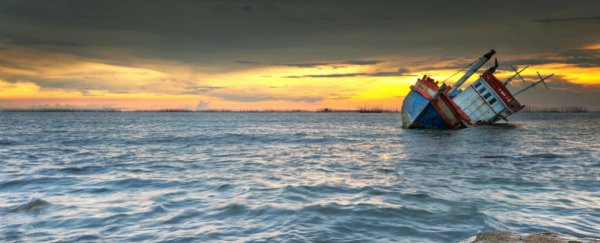If your internet rabbit holes have ever taken you to the mystery of the Bermuda Triangle 'death trap', you've probably come across one explanation where methane bubbles create a bizarre sinkhole situation in the middle of the ocean.
It sounds cool, but as the video below explains, it's a load of, well, sea farts, because firstly, ships are specifically designed to combat these bubbles, and secondly, the infamous Bermuda Triangle doesn't actually exist.
Let's start with that first fact.
As University College London oceanographer and physicist Helen Czerski explains to Tech Insider, bubbles could theoretically sink ships like this, as one geophysicist proposed last year - but that's not really the point.
In the video below, Czerski says it all starts with methane building up in the sea floor, and some kind of disturbance can release it into the ocean as one big gust.
This giant gust of bubbles will rise to the surface, and along the way, break up into tiny bubbles.
These tiny bubbles will drag water with them as they zoom upwards, and that water has momentum, so it whooshes up above the surface and could technically tip whatever's floating on the surface.
But the only thing this phenomenon is capable of sinking is a really crappy ship, because the vessel would have to be already heavily tilted to one side for the methane bubbles to push the whole thing over and sink it.
As Czerski points out, every ship these days is built to prevent disturbances on the surface from tipping it over, so what actually happens when these methane leaks occur is they simply push the ship to one side.
And now to our second point - while there is an area of the ocean called the Bermuda Triangle - a region bordered by Florida, Bermuda, and Puerto Rico - there's no actual point to it, because there are no more unexplained plane crashes and shipwrecks in the area than anywhere else in the ocean, despite what you might have heard.
As Fiona MacDonald reported for us back in October, the Bermuda Triangle was first brought to public attention back in the 1950s by a journalist named Edward Van Winkle Jones, who wrote a story for the Associated Press about a large number of ships and planes that had disappeared in the region.
Then in the 1970s, author Charles Berlitz published The Bermuda Triangle - a best-selling book that spawned rumours of UFOs or rogue waves in the region.
"But the problem was, no one had actually fact-checked the claims of boats and planes going missing," MacDonald reports.
"And when journalist Larry Kusche actually did a few years later, he discovered there was actually no mystery to solve in the first place."
So no death trap, and no methane bubbles.
Watch the Tech Insider video below to see how these bubbles work (or don't) in the most overhyped place in the ocean:
